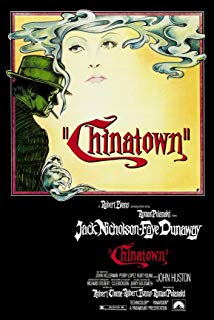電影訊息
電影評論更多影評

2014-02-18 00:43:04
真實背景知識
補充真實背景知識。看電影前或看電影后看看這篇文章,更好地理解電影。
Jun 25th 2010, 15:00 by N.V. | LOS ANGELES
作者:N.V. 2010年6月25日/l洛杉磯 譯者: jennifer2010
WERE it not for several remarkable feats of civil engineering, the City of Angels would still be a sleepy town on the banks of a small, meandering river in southern California. In 1880, the population of Los Angeles and adjacent communities stood at a mere 33,000. By 1930, it had leaped to 2.2m. Today, the city and its dormitory towns—the most populous county in America—is home to 10m residents and the hub of a local economy bigger than South Korea’s.
如果不是因為幾個重大的土木工程,洛杉磯可能還是加利福利亞南部的某蜿蜒小河沿岸的一座沉睡的小鎮。1880年時,洛杉磯及其毗鄰社區人口只有33,000。到1930年時,人口激增到了2,200,000。如今,這個城市及其阜城——美國人口最多的城市——有著1千萬居民,其當地的經濟中心比韓國的還要大。
What fuelled Los Angeles’s explosive growth during the early part of the 20th century was a reliable supply of water. With barely a drop on its own doorstep, the city secured supplies from lakes to the north and the Colorado River to the east. Water rights were negotiated with farmers, bond issues approved, and a series of dams, aqueducts, tunnels and pipelines built to pump water hundreds of miles across deserts and over mountains to the southwest.
二十世紀初期激起洛杉磯爆炸性增長的是其可靠的水資源供給。儘管自身沒有一滴水,該市還是利用其北部的湖泊和東部的科羅拉多河確保了水源供應。水利部門和農民協商,通過發行債券,穿沙漠,越山嶺建立了一系列的堤壩、渡槽、隧道、管道,將數百英里以外的西南部的水輸送到該市。
For that, Angelenos have to thank 威廉 Mulholland, head of the city’s Department of Water and Power at the time. Mulholland Drive—the scenic ridgeline route, with views of the Los Angeles basin to the south and San Fernando Valley to the north—was named in honour of this civil engineer, who died in 1935 before seeing his crowning glory.
為此,洛杉磯市民都很感激那時水電部門的領導威廉·穆赫蘭(威廉 Mulholland)。穆赫蘭道(Mulholland Drive)——為一條南有洛杉磯盆地北有聖費爾南多谷(San Fernando Valley)的風景秀麗的山脊路線——便是為了紀念這位土木工程師,他於1935年去世,未來得及看看他這無比壯觀的工程。
No surprise, however, that the whole endeavour was knee-deep in corruption. The residents of the city may have footed the bill for the water rights bought in Owens Valley in the Eastern Sierras as well as for the 230-mile aqueduct to channel the snow-fed water by gravity to the south. But in 1913, when the Los Angeles Aqueduct opened, it ended its journey at a reservoir in San Fernando Valley, where speculators in the know had bought cheap land ready for a water-fed bonanza. Only later, when the property developers had had their fill, did the imported water get pumped over the mountains to feed the Los Angeles water supply.
然而,毫無疑問,這項工程中也浸透著腐敗。洛杉磯的居民可能不僅計算了購買東錫拉斯(the Eastern Sierras)歐文斯流域(Owens Valley)水權的費用,還計算了利用重力將那裡的融雪補給水通過230英裡的渡槽引向南方的費用。可是1913年洛杉磯渡槽(the Los Angeles Aqueduct)啟動時,卻在中途聖費爾南多流域(San Fernando Valley)的一個水庫終止了,知情的投機商預先低價買下了那裡的土地,為水利將給他們帶來的利益作好了準備。直到地產開發商拿到他們的利潤後,輸入的水才得以泵過山嶺滿足洛杉磯的水供給。
Other shenanigans followed. By 1928, the Los Angeles Aqueduct had drained the 100-square-mile Owens Lake dry, diverted the Owens River and turned much of the Owens Valley into a dust bowl. Local farmers rebelled by opening sluice gates and dynamiting the aqueduct. (The 1974 neo-noir movie 「Chinatown」 was based on the insider land grab by speculators and the bitter water wars the Department of Water and Power fought during the 1930s with Owens Valley residents.)
其他的伎倆也是一個接著一個。1928年洛杉磯渡槽抽乾了100平方英裡的歐文斯湖,轉到歐文斯河,致使大部份歐文斯流域變成沙塵暴區。當地農民反對政府,打開了閘門,炸毀了渡槽。(1974年的新黑色電影「唐人街」就是以內部搶奪土地的投機商及20世紀30年代水電部門和歐文斯流域居民艱巨的爭水之戰為背景的。)
By then, however, Mulholland had turned his attention east to the Colorado River as another potential source of water for Los Angeles. In 1931, voters approved a $220m bond issue (over $3 billion in today's money) to build the 240-mile Colorado River Aqueduct, a project that required the mighty Hoover Dam (the world's largest concrete structure at the time) to be completed first.
不過,那時穆赫蘭已經將注意力轉向科羅拉多河,將那裡作為洛杉磯潛在的水資源。1931年,選舉人通過了發行2.2億債券(市值超過如今的30億)以建造全程240英里長的科羅拉多河渡槽(Colorado River Aqueduct),這項工程需要先完成巨大的胡佛大壩(當時世界上最大的混凝土建築)。
In good years, Los Angeles gets two-thirds of its water from the Colorado River and the California Aqueduct built in the 1960s to distribute water from the San Joaquin-Sacramento River delta to farmers in Central Valley and communities along the way. One of the aqueduct's southern branches terminates at Castaic Lake on the northern fringes of Los Angeles.
年頭好時,洛杉磯可以從科羅拉多河得到2/3的水源,20世紀60年代建立的加利福利亞渡槽可以將聖華金-薩克拉門托河三角洲(the San Joaquin-Sacramento River delta)的水源提供給中央山谷及沿岸社區的農民。該渡槽向南的一個分支是到洛杉磯附近的卡斯泰克湖(Castaic Lake)。
Meanwhile, the Los Angeles Aqueduct from Owens Valley—subsequently extended 40 miles further north to Mono Lake to tap additional run-off from the Eastern Sierra snowpack—normally provides about a quarter of the city’s needs. The remaining 10% or so comes from groundwater, and a minuscule amount from recycling.
同時,源於歐文斯流域的洛杉磯渡槽——隨後向北延伸了40英里到莫諾湖(Mono Lake)以利用來自東部獅子山(the Eastern Sierra)的積雪——一般能為洛杉磯提供1/4的水源。剩餘的10%左右來自地下水,只有極少量是來自大氣循環。
But since 2007, California has been in the throes of a drought. In Los Angeles, a water conservation ordinance, introduced last summer, restricts watering gardens to just two days a week (Mondays and Thursdays) and then only during the hours between 4pm and 9am. Residents are forbidden to use water to wash down paths and pavements, or to use a hose without an automatic shut-off valve. Restaurants are even banned from serving customers iced water unless they specifically ask for it.
但自從2007年,加利福利亞陷入了乾旱的困境。洛杉磯去年夏天提出了一個水保護條例,限制只能一週兩次(週一和週四),在下午4點到次日上午9點這個時間段澆灌花園。禁止居民用水清洗道路和人行道,或使用沒有自動斷閥裝置的水龍頭。餐館甚至除了在客人特地要求時禁止提供冰水。
And yet, spring storms smothered the Sierras in snow this year. Rainfall over much of the state has been 115% of average. The state’s biggest reservoir—Lake Shasta in northern California—is full to the brim, with a water level way above its historical average. In general, reservoirs are at normal or above-normal levels for this time of year. To all intents and purposes, California’s drought is done.
然而,今年的春季風暴席捲了大雪覆蓋的錫拉斯(the Sierras)。這個州的降雨已經超過了往年均線的15%。其最大的水庫——加利福利亞北部的沙斯塔湖(Lake Shasta)——水位已經超過了歷史均線達到水庫邊緣。一般情況下,一年的這個時候,水庫的水位都會處在正常或高於正常水位線。不管怎麼說,加利福利亞的乾旱終於過去。
But the governor, Arnold Schwarzenegger, shows no sign of lifting the emergency declaration he imposed in June 2008. Nor is Los Angeles about to end its watering restrictions. And the Metropolitan Water District—the wholesaling agency that allocates water from the Colorado to Los Angeles and other communities in southern California—is not exactly opening up its pumping valves. Because of changing weather patterns, the Rocky Mountains, where the Colorado River rises, have been getting only three-quarters of their traditional snowfall. As a consequence, the Colorado’s flow has been well below normal for eight out of the past nine years.
但是沒有任何跡象表明州長阿諾德·施瓦辛格要結束他2008年6月強制發佈的緊急聲明。洛杉磯也沒有打算終止用水限制。而且,大都會水區——從科羅拉多向洛杉磯及加利福利亞南部其他社區供水的批發代理機構——並沒有開放其抽水閘。由於不斷變化的天氣,科羅拉多河的源頭落基山脈(the Rocky Mountains)只有相當於以往3/4的降雪量。因此,科羅拉多河在過去幾年裡也遠低於正常的流量。
The two biggest worries, though, for the southern half of California reside up north. One is the ecological collapse of the San Joaquin-Sacramento delta—the hub of California’s water system. State authorities have ordered cutbacks in deliveries of water from the delta because of the threat to endangered species of salmon and smelt. This year, southern California will receive only 45% of the water it is contractually entitled to.
然而,讓南加州的居民依賴於北部水源,有兩個很令人擔憂的地方。一個是聖華金-薩克拉門托河三角洲(the San Joaquin-Sacramento River delta)——加利福利亞水系統中心的生態崩潰。由於鮭魚和胡瓜魚這些瀕危物種受到威脅,國家當局已經要求消減從該三角洲往外輸水的量。今年南部加利福利亞只能獲得原合同中45%的水了。
The other big worry resides in Sacramento itself. Last November, California’s normally dysfunctional legislature surprised everyone by passing a comprehensive package of bills to rescue the delta and bring the state’s water infrastructure into the 21st century. To pay for everything, the package included $11.1 billion of water bonds that will be placed on this coming November’s ballot for voter approval.
另一個大憂患是薩卡拉門托(Sacramento)自身。去年十一月,加利福利亞一貫功能失調的立法機構宣佈了一項讓所有人吃驚的全面一攬子議案,援救該三角洲地區,並要將該州水利基礎設施帶入21世紀。為了支付所有費用,需要發行111億水債券,這一攬子議案將會在即將到來的十一月投票中,由選民批准。
In the meantime, people throughout California, especially residents of the populous south, are being reminded daily—by continued shortages and restrictions—that those bond issues really do need to be approved. So, Californians can expect no easing of their water cutbacks until after the November ballot.
同時,全加州人民,尤其是人口眾多的南部日夜被不斷的缺水和用水限制困擾著——這使得批准發行債券很有必要。因此,加利福利亞人民在十一月的投票前不要指望政府能夠放鬆對他們的用水限制。
No question, large sections of California’s water system—much of it untouched for decades—need wholesale replacement. But there are two fallacies in the water policies adopted by all sprawling communities in the American sunbelt that are as true today as they were in Mulholland’s time.
毫無疑問,加州的大部份水系統——很多都是數十年沒用過了——需要整體的更換。但是美國陽光地帶的廣大社區在用水政策上和穆赫蘭時期一樣存在兩個謬誤。
First, the constant pursuit of additional supplies of water has never been strictly about satisfying a demand from communities that were supposedly running dry. It has always been more about creating demand for real estate in places where water was scarce or non-existent. As always, the inequity is that the huge infrastructure projects needed are paid for by existing customers, while future customers reap the benefits.
首先,不斷地追求新的水供應沒能很好地滿足那些即將乾涸的社區需求。而是為那些水資源匱乏或根本沒水地區的房地產創造了需求。和以往一樣,不公平在於那些巨大的基礎建設工程費用是由現有客戶支付的,而受益人卻是將來的客戶。
The second fallacy lies in the way water is priced. Experts agree that the climate is generally getting warmer, which means there is less snow on the mountains to melt in the spring, fill the rivers and recharge the aquifers. In other words, long-term water shortages are real. But they are aggravated by the way people are charged for how much they use. For instance, your correspondent pays $3.90 per hundred cubic feet of water. That works out at just half a cent a gallon.
第二個謬誤是水定價的方式。專家們都贊同氣候正在變暖的觀點,這意味著春天來自山上可以融化補給河流和含水層的雪變少了。換句話說,長期的水資源不足是事實。但是被人們根據使用量付費的方式嚴重化了。例如,100立方水的價格是3.9美元,1加侖水的價格只有0.5分。
Silly prices like that send the wrong signal to the market. With people having little incentive to conserve, the authorities then have to resort to rationing when droughts occur. That is neither efficient nor fair: it penalises those who use water sparingly as much as those who waste it. In an ideal world, water would be priced so as to reflect its scarcity. In periods of drought, its price would increase and people would therefore demand less.
不合理的價格給市場傳遞了錯誤的資訊。由於人們沒有了儲存水的動機,當局不得不在乾旱時採取定量配給。可這既沒有效率也不公平:一樣對待那些節約用水和浪費的人。在理想情況下,水價是應該用來反映其稀缺程度的。乾旱時期,上調價格以降低人們對水的需求。
It is not a perfect world, least of all in California. But nor is it beyond the wit of those in charge to consider water like oil or any other commodity, and to use market mechanisms to match supply and demand. Your correspondent, for one, would welcome the chance to pay proportionately more to water his garden once a day instead of merely twice a week. Perhaps he will get the chance after November.
可這畢竟不是個理想的世界,至少加利福利亞是這樣的。但也不至於像管理者想的那樣:水價會超過油或其他日用品,或者要用市場機制來平衡供需。如果你想每天能給花園澆次水,而不是一週兩次,就可能會歡迎相應多付點錢的方式。當局可能會在11月後給你這個機會。
摘自
http://article.yeeyan.org/view/154424/114395
評論

